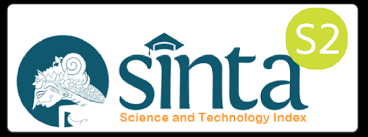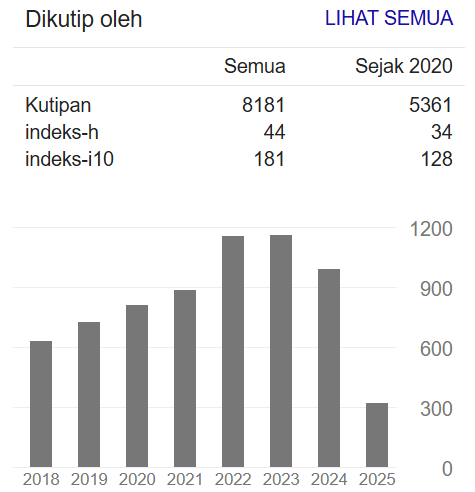A TIME-CRITICAL DECISIONS: HEART SCORE'S IMPACT ON CARDIAC EMERGENCY OUTCOMES: INTEGRATED LITERATURE REVIEW
DOI:
https://doi.org/10.34011/jmp2k.v35i3.2825Keywords:
kegawatdaruratan jantung, keterlambatan, ketidakpastian, kredibilitas, skor HEARTAbstract
Ketidakpastian dan keterlambatan penanganan kegawatdaruratan jantung menjadi penyebab tingginya angka kematian pasien di Indonesia hingga saat ini sebesar 13 juta. Penelitian ini bertujuan untuk mengumpulkan bukti kredibilitas skor HEART untuk mendeteksi kegawatdaruratan jantung guna mencegah ketidakpastian dan keterlambatan penanganan. Tinjauan sistematis dilakukan dengan menelusuri basis data Taylor & Francis, Springer Link, dan Science Direct yang diterbitkan antara tahun 2019 dan 2024. Data dianalisis menggunakan analisis isi deduktif mengenai kredibilitas skor HEART dalam mendeteksi kegawatdaruratan jantung. Hasil analisis menunjukan hanya sepuluh artikel yang mengekstraksi data dari skor HEART, yang memberikan kepastian serta mendukung penanganan yang cepat. Alat yang digunakan untuk komponen skor HEART harus dikalibrasi. Para peneliti menemukan bahwa skor HEART akurat mendeteksi kegawatdaruratan jantung (80%), cukup efektif dalam mendeteksi kejadian darurat jantung (60%), dan dapat digunakan untuk mengevaluasi pasien selama dan setelah kegawatdaruratan (50%). Kesimpulannya, skor HEART merupakan alat deteksi kegawatdaruratan yang efisien. Keberhasilan skor HEART dalam mengatasi ketidakpastian dan keterlambatan kegawatdaruratan jantung membutuhkan hubungan interpersonal dengan kolaborasi.
References
D. Portal, R. Hirsch, and M. Benderly, “Increased prevalence of cardiac and non-cardiac chronic morbidity among adults with congenital heart disease,” International Journal of Cardiology Congenital Heart Disease, vol. 7, p. 100314, Mar. 2022, doi: 10.1016/j.ijcchd.2021.100314.
Y. M. Soeli, Z. B. Pomalango, R. Hunawa, and S. F. M. Arsad, “Simulation of bystander cardiopulmonary resuscitation and butterfly hug therapy towards the ability to perform emergency assistance for cardiac arrest,” Malaysian Journal of Nursing, vol. 15, no. 1, pp. 101–106, Jul. 2023, doi: 10.31674/mjn.2023.v15i01.012.
J. Reyes et al., “Utility of serial conventional troponin testing for emergency department patients stratified by HEART score and symptom timing,” American Journal of Emergency Medicine, vol. 69, pp. 173–179, Jul. 2023, doi: 10.1016/j.ajem.2023.04.044.
A. Šljivo et al., “HEART Score and Its Implementation in Emergency Medicine Departments in the West Balkan Region—A Pilot Study,” Healthcare, vol. 11, no. 17, p. 2372, Aug. 2023, doi: 10.3390/healthcare11172372.
I. N. S. R. Arispe, J. Sol, A. C. Gil, J. Trujillano, M. O. Bravo, and O. Y. Torres, “Comparison of heart, grace and TIMI scores to predict major adverse cardiac events from chest pain in a Spanish health care region,” Sci Rep, vol. 13, no. 1, p. 17280, Oct. 2023, doi: 10.1038/s41598-023-44214-3.
M. Campbell et al., “Synthesis without meta-analysis (SWiM) in systematic reviews: Reporting guideline,” The BMJ, vol. 368, Jan. 2020, doi: 10.1136/bmj.l6890.
T. F. Frandsen, M. F. Bruun Nielsen, C. L. Lindhardt, and M. B. Eriksen, “Using the full PICO model as a search tool for systematic reviews resulted in lower recall for some PICO elements,” J Clin Epidemiol, vol. 127, pp. 69–75, Nov. 2020, doi: 10.1016/j.jclinepi.2020.07.005.
K. E. K. Chai, R. L. J. Lines, D. F. Gucciardi, and L. Ng, “Research Screener: a machine learning tool to semi-automate abstract screening for systematic reviews,” Syst Rev, vol. 10, no. 1, Dec. 2021, doi: 10.1186/s13643-021-01635-3.
Y. C. Park and K. H. Park, “Interprofessional education program for medical and nursing students: Interprofessional versus uniprofessional,” Korean J Med Educ, vol. 33, no. 1, pp. 1–10, 2021, doi: 10.3946/KJME.2021.182.
A. H. Du Plessis, D. R. M. van Rooyen, S. Jardien-Baboo, and W. ten Ham-Baloyi, “Screening and diagnosis of women for chorioamnionitis: An integrative literature review,” Oct. 01, 2022, Churchill Livingstone. doi: 10.1016/j.midw.2022.103417.
R. Barron et al., “Influence of Patient and Clinician Gender on Emergency Department HEART Scores: A Secondary Analysis of a Prospective Observational Trial,” in Annals of Emergency Medicine, Elsevier Inc., 2023. doi: 10.1016/j.annemergmed.2023.03.016.
G. Akman et al., “T-MACS score vs HEART score identification of major adverse cardiac events in the emergency department,” American Journal of Emergency Medicine, vol. 64, pp. 21–25, Feb. 2023, doi: 10.1016/j.ajem.2022.11.015.
A. U. Khand et al., “HEART Score Recalibration Using Higher Sensitivity Troponin T,” Ann Emerg Med, Jun. 2023, doi: 10.1016/j.annemergmed.2023.04.024.
R. Check et al., “Patients’ sex and race are independent predictors of HEART score documentation by emergency medicine providers,” American Journal of Emergency Medicine, vol. 51, pp. 308–312, Jan. 2022, doi: 10.1016/j.ajem.2021.10.040.
G. W. A. Aarts et al., “Implementation of the ESC 0 h/1h algorithm and the HEART score in the emergency department: A prospective cohort study,” IJC Heart and Vasculature, vol. 39, Apr. 2022, doi: 10.1016/j.ijcha.2022.100988.
Z. Faramand, C. Martin-Gill, S. O. Frisch, C. Callaway, and S. Al-Zaiti, “The prognostic value of HEART score in patients with cocaine associated chest pain: An age-and-sex matched cohort study,” American Journal of Emergency Medicine, vol. 45, pp. 303–308, Jul. 2021, doi: 10.1016/j.ajem.2020.08.074.
W. E. Soares et al., “A Prospective Evaluation of Clinical HEART Score Agreement, Accuracy, and Adherence in Emergency Department Chest Pain Patients,” Ann Emerg Med, vol. 78, no. 2, pp. 231–241, Aug. 2021, doi: 10.1016/j.annemergmed.2021.03.024.
D. G. Mark, J. Huang, C. J. Kennedy, D. R. Vinson, D. W. Ballard, and M. E. Reed, “60-day major adverse cardiac events in emergency department patients with non-low modified HEART scores,” American Journal of Emergency Medicine, vol. 38, no. 12, pp. 2760.e5-2760.e8, Dec. 2020, doi: 10.1016/j.ajem.2020.05.081.
D. N. van Dongen et al., “Accuracy of pre-hospital HEART score risk classification using point of care versus high sensitive troponin in suspected NSTE-ACS,” American Journal of Emergency Medicine, vol. 38, no. 8, pp. 1616–1620, Aug. 2020, doi: 10.1016/j.ajem.2019.158448.
W. Barta, “Hildegard Peplau’s Interpersonal Relations Theory: Enhancing Therapeutic Nurse-patient Relationships,” Res Rev J Nurs Health Sci, vol. 9, no. 4, pp. 1–2, Jul. 2023, doi: 10.4172/JNHS.2023.9.4.90.
Alligood, Nursing Theorists and Their Work, Ninth Edition. United States of America: Elsevier, 2018. Accessed: Feb. 16, 2025. [Online]. Available: https://www.academia.edu/57388621/Nursing_theorist_and_their_work
M. Li, Q. Gao, and T. Yu, “Kappa statistic considerations in evaluating inter-rater reliability between two raters: which, when and context matters,” Dec. 01, 2023, BioMed Central Ltd. doi: 10.1186/s12885-023-11325-z.
Ş. K. Çorbacıoğlu and G. Aksel, “Receiver operating characteristic curve analysis in diagnostic accuracy studies: A guide to interpreting the area under the curve value,” Turk J Emerg Med, vol. 23, no. 4, pp. 195–198, Oct. 2023, doi: 10.4103/tjem.tjem_182_23.
T. F. Monaghan et al., “Foundational statistical principles in medical research: Sensitivity, specificity, positive predictive value, and negative predictive value,” 2021, MDPI AG. doi: 10.3390/medicina57050503.
Downloads
Published
How to Cite
Issue
Section
Citation Check
License
Copyright (c) 2025 Permaida Permaida, Komang Noviantari, Ina Yuhana

This work is licensed under a Creative Commons Attribution-ShareAlike 4.0 International License.




